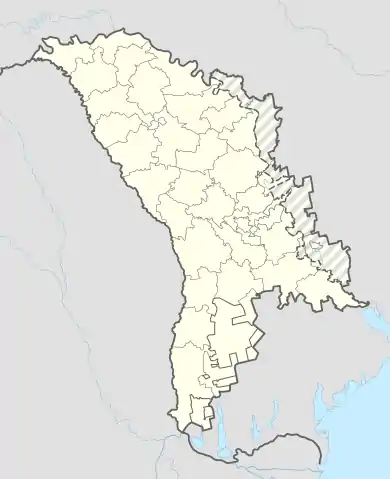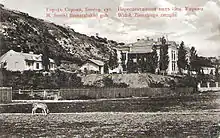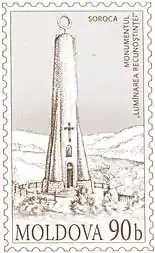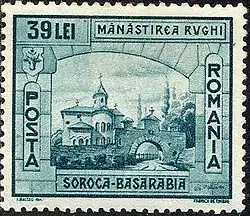Soroca
Soroca is a city and municipality[2] in Moldova, situated on the Dniester River about 160 km (99 mi) north of Chișinău. It is the administrative center of the Soroca District.
Soroca | |
|---|---|
Soroca Fort and Soroca | |
 Coat of arms | |
 Soroca | |
| Coordinates: 48°10′N 28°18′E | |
| Country | |
| County | Soroca |
| Government | |
| • Mayor | Lilia Pilipețchi |
| Area | |
| • Total | 11.88 km2 (4.59 sq mi) |
| Elevation | 45 m (148 ft) |
| Population | |
| • Total | 22,196 |
| • Density | 1,900/km2 (4,800/sq mi) |
| Time zone | UTC+2 (EET) |
| • Summer (DST) | UTC+3 (EEST) |
| Postal code | MD-3001 |
| Area code | +373 230 |
| Website | Official website |
History

The city has its origin in the medieval Genoese trade post of Olchionia, or Alchona. It is known for its well-preserved stronghold, established by the Moldavian prince Stephen the Great (Ștefan cel Mare in Romanian) in 1499.[3] The origins of the name Soroca are not fully known. Soroca (Russian: сорока) means Magpie in Russian.[4] Its location is only a few kilometers from the Moldova–Ukrainian border.
The original wooden fort, which defended a ford over the Dniester, was an important link in the chain of fortifications which comprised four forts (e.g., Bilhorod-Dnistrovskyi, then known as Akkerman, and Khotyn) on the Dniester, two forts on the Danube, and three forts on the north borders of medieval Moldavia. Between 1543 and 1546, under the rule of Peter IV Rareș, the fort was rebuilt in stone as a perfect circle with five bastions situated at equal distances.
During the Great Turkish War, John III Sobieski's forces successfully defended the fort against the Ottomans. It was of vital military importance during the Pruth River Campaign of Peter the Great in 1711. The stronghold was sacked by the Russians in the Austro-Russian–Turkish War (1735–39). The Soroca Fort is an important attraction in Soroca, having preserved cultures and kept the old Soroca to the present day.
The locality was greatly extended in the 19th century, during a period of relative prosperity. Soroca became a regional center featuring large squares, modernized streets, hospitals, grammar schools and conventionalized churches. During the Soviet period, the city became an important industrial center for northern Moldova.[5]
Soroca was known for producing grapes, wheat, maize, and tobacco in 1919.[3]
Climate
The climate in Soroca is a warm-summer subtype (Köppen: Dfb) of the humid continental climate.
| Climate data for Soroca (1991–2020) | |||||||||||||
|---|---|---|---|---|---|---|---|---|---|---|---|---|---|
| Month | Jan | Feb | Mar | Apr | May | Jun | Jul | Aug | Sep | Oct | Nov | Dec | Year |
| Average high °C (°F) | 0.0 (32.0) |
2.1 (35.8) |
8.3 (46.9) |
16.3 (61.3) |
22.0 (71.6) |
25.6 (78.1) |
27.5 (81.5) |
27.4 (81.3) |
21.5 (70.7) |
14.5 (58.1) |
7.0 (44.6) |
1.4 (34.5) |
14.5 (58.1) |
| Daily mean °C (°F) | −2.9 (26.8) |
−1.4 (29.5) |
3.5 (38.3) |
10.4 (50.7) |
16.0 (60.8) |
19.6 (67.3) |
21.3 (70.3) |
20.8 (69.4) |
15.6 (60.1) |
9.5 (49.1) |
3.8 (38.8) |
−1.3 (29.7) |
9.6 (49.3) |
| Average low °C (°F) | −5.3 (22.5) |
−4.3 (24.3) |
−0.5 (31.1) |
5.0 (41.0) |
10.2 (50.4) |
14.0 (57.2) |
15.5 (59.9) |
14.7 (58.5) |
10.2 (50.4) |
5.3 (41.5) |
1.1 (34.0) |
−3.7 (25.3) |
5.2 (41.4) |
| Average precipitation mm (inches) | 30 (1.2) |
28 (1.1) |
31 (1.2) |
39 (1.5) |
56 (2.2) |
67 (2.6) |
80 (3.1) |
50 (2.0) |
54 (2.1) |
38 (1.5) |
40 (1.6) |
28 (1.1) |
542 (21.3) |
| Average precipitation days (≥ 1.0 mm) | 6 | 6 | 6 | 7 | 8 | 7 | 8 | 6 | 6 | 5 | 6 | 6 | 76 |
| Source: NOAA[6] | |||||||||||||
Demographics
The population was estimated at 35,000 in 1919. It consisted mainly of Jews. Romanians, Germans, and Russians also lived in the city.[3] The city once had a Jewish population of around 18,000, but there are only 100 today and 20 of them are considered Jewish according to the halakha.[7]
In 2012, Soroca had an estimated 37,500 inhabitants.
The city has a sizable Romani minority and is popularly known as the "Romani capital of Moldova".[8]
Mayor
The Mayor of Soroca is head of the executive branch of Soroca City Council.[9]
| List of mayors of Soroca | ||||
|---|---|---|---|---|
| Name | From | Until | Party | Pool |
| Mihail Popovschi[10] | 2003 | 2007 | PCRM | 2003 |
| Victor Său | 2007 | 2011 | PNL | 2007 |
| Elena Bodnarenco | 2011 | 2015 | PCRM | 2011 |
| Victor Său | 2015 | 2019 | PLDM | 2015 |
| Lilia Pilipețchi | 2019 | Present | PSRM | 2019 |
Natives
| Year | Pop. | ±% |
|---|---|---|
| 1897 | 15,351 | — |
| 1919 | 35,000 | +128.0% |
| 1930 | 14,661 | −58.1% |
| 1959 | 14,895 | +1.6% |
| 1970 | 24,465 | +64.2% |
| 1979 | 31,831 | +30.1% |
| 1989 | 42,297 | +32.9% |
| 2004 | 28,362 | −32.9% |
| 2012 | 37,500 | +32.2% |
| Source: [11][12] | ||
- Samuel Bronfman (1889–1971), a Canadian entrepreneur, former owner of Seagram
- Alexandru Cimbriciuc
- Arkady Gendler (1921–2017), Ukrainian Yiddish Singer
- Sofia Imber, a Venezuelan journalist, founder of the Contemporary Art Museum of Caracas
- Isaac Kitrosser, French photojournalist
- Anna Mincovschi, mother of Robert Hossein
- Kira Muratova, a Soviet and Ukrainian film director, screenwriter and actress
- David Seltzer (1904–1994), New York Yiddish language writer, journalist and poet
- Marina Shafir, a Moldovan mixed martial arts and professional wrestler currently works for All Elite Wrestling.
- Nicolae Șoltuz, a member of Sfatul Țării
- Robert Steinberg, a Canadian mathematician
- Leonte Tismăneanu, a Romanian communist activist
- Eugen Ţapu (1983–2009), a protester in the post-election riots in Chișinău who died while in police custody
- Gheorghe Ursu (1926–1985), a Romanian construction engineer and dissident
- Mark Tkaciuk, historian, politician
Media
- Observatorul de Nord, a newspaper from Soroca, founded in 1998[13][14]
- Vocea Basarabiei, 67,69 and 103.1
Gallery

.jpg.webp)



.jpg.webp) Soroca 1898 local stamp
Soroca 1898 local stamp
International relations
References
- Results of Population and Housing Census in the Republic of Moldova in 2014: "Characteristics - Population (population by communes, religion, citizenship)" (XLS). National Bureau of Statistics of the Republic of Moldova. 2017. Retrieved 1 May 2017.
- LEGE Nr. 248 din 03.11.2016 pentru modificarea și completarea Legii nr. 764-XV din 27 decembrie 2001 privind organizarea administrativ-teritorială a Republicii Moldova (in Romanian)
- Kaba, John (1919). Politico-economic Review of Basarabia. United States: American Relief Administration. pp. 13–14.
- "СОРОКА - Translation in English - bab.la". en.bab.la. Retrieved 29 July 2021.
- Tourist towns of Moldova Archived 22 July 2011 at the Wayback Machine
- "Soroca Climate Normals 1991–2020". World Meteorological Organization Climatological Standard Normals (1991–2020). National Oceanic and Atmospheric Administration. Archived from the original on 21 August 2023. Retrieved 21 August 2023.
- "Moldovan Jews struggle to maintain their historic community amid poverty, anti-Semitism". Jewish Telegraphic Agency. 20 June 2012. Retrieved 9 January 2014.
- Steve Kokker, Cathryn Kemp (2004) "Romania and Moldova" (a travel guide), ISBN 1-74104-149-X p.322
- "Loading". primsoroca.md.
- "Ce se întâmplă la Soroca?".
- "Demoscope Weekly - Annex. Statistical indicators reference". demoscope.ru.
- "Moldova: Districts, Communes, Cities, Urban Settlements - Population Statistics in Maps and Charts". citypopulation.de.
- Radio Free Europe/Radio Liberty, „Nici tu ploaie ca lumea, nici tu limpezirea apelor în domeniul politicii”
- Reporter european Archived 22 July 2011 at the Wayback Machine
Further reading
- Soroki/Soroca (pp. 376–380) at Miriam Weiner's Routes to Roots Foundation
.jpg.webp)
.jpg.webp)
.jpg.webp)
.jpg.webp)
.jpg.webp)
